By Lucy Komisar
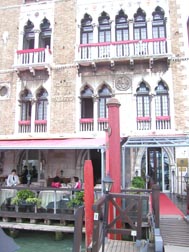
Sitting on the “Bar Canale” terrace for breakfast, gazing at the 17th century Church of Santa Maria della Salute across the Grand Canal, I could imagine the lazy mornings of the Venice nobles who once owned the Bauer Il Palazzo. They might have finished their coffees and walked the five minutes to the Palace of the Doges, where government business was carried out.
They or their servants might have stepped into a gondola to travel quickly to the Rialto, the market at the site of the famous bridge. That might have happened in the 18th century, when the Palazzo was built.
By a century later, in 1880, this elegant building was a hotel, reputed for thermal treatments with the water from the canal. Patrons could take it in their rooms for sea bath treatments. Arnaldo Bennati, a Genoan shipping tycoon, bought the palazzo in 1930. In the 1940s, he added an original 17th century gothic-Byzantine style fa§ade and a modern addition, The Bauer. That is where we stayed for a magical two days – in a room with a terrace from which we could see and almost touch the buildings of San Marcos Square.
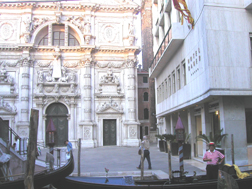
The newer building, fronting on the Campo San Mois¨, has a fa§ade typical of the forties and was quite controversial when it was built, with the design ordered by Rome. It shares the piazza with the baroque church of that name. Gondoliers wait for passengers at the San Mois¨ canal bridge near the hotel entrance.
I got a tour of the Bauer and the Palazzo from Bennati‘s granddaughter, Francesca Bortolotti Possati, who became CEO in 1997. She returned to live in Venice only nine years ago, after spending 11 years in America, where she took a degree in English literature and lived in Dallas, Blooomfield, Michigan, and New York City. In New York, she was a consultant to interior designers and decorators. She refurbished and expanded the properties with a passion illuminated by her experience in design.
Inside the hotels, the results of her sensibilities are evident. The Palazzo rooms have marble floors, silk brocade walls, gilded furniture and other antiques. The chandeliers are of hand-blown Murano glass. Visiting the 7th-floor Settimo Cielo (Seventh Heaven) terrace restaurant, we passed a hallway with silk wall covering in a Chinese dog pattern, tapestries in red, green and gold, and lamps from Murano.
Talking to Signora Bartolotti Possati on the terrace, I could see the Church of Santa Maria della Salute in the background. Room balconies also overlook the Grand Canal. The lobby displays high-fashion antiques, with 18th-century Venetian lacquered panels in Chinese designs. Even the more modern Bauer reflects history; the lobby features a huge tiled aerial view of old Venice.
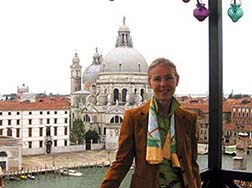
Francesca Bortolotti Possati is a hands-on executive, conferring with her managers throughout the day. But weekends, she drives northeast to the family vineyard and dairy farm. The vineyard in Collio, Friuli, near the Slovenian border, makes “Colmello di Grotta” red and white wine. The farm, closer to Trieste, produces milk, cheese, butter, and yogurt. Both wine and dairy products are served at the hotel. In the intimate Palazzo bar, we set a computer on a coffee table and checked email via wifi while quaffing Colmello white and nibbling elegantly presented canapés.
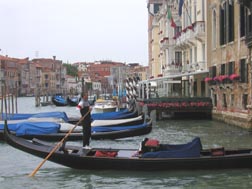
One can also have drink or coffee on the terrace and relax while gazing at gondoliers passing by or tying up at the nearby dock.
This fashionable place is popular with the people who run the Biennale, the international festival that draws the world‘s top artists and performers in June. Signora Bortolotti Possati described it as “three days of turmoil” in which the Bauer and Palazzo host parties, receptions, and art exhibits.
This summer, the Settimo Cielo terrace was chosen for the Biennale opening dinner, attended by the president and prime minister of Italy, the mayor of Venice, and the country‘s minister of culture and tourism. The
hotels also hosted the German pavilion and a reception for American artists. A nearby balcony held four red penguins, part of a “brood” scattered around the city — a Biennale “art work!”
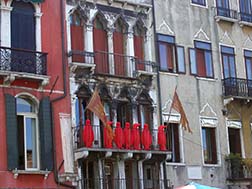
Signora Bortolotti Possati is concerned about the artistic preservation of the city, which is endangered by flooding, and she serves on the board of Save Venice, an American non-profit restoration organization. “At San Marco and the Rialto, the lowest places, we have in some areas raised the level of the stones in the center of street 10 centimeters,” she explained. “We can‘t make it high on the sides because of the shops.” The Bauer hosts monthly lectures on Venice history; upcoming events are posted on the hotel website.
One of those lectures could tell the history of the Venice aristocrats who were the Palazzo‘s first owners and who, happily, passed it on eventually to the Bennatis so that travelers could enjoy it!
Hotel Bauer
San Marco 1459
30124 Venice, Italy
Bauer Il Palazzo – Venezia
San Marco 1413/d
30124 Venice, Italy
Tel 39 041 520 7022
Fax: 39 041 520 7557
Reservations: 39 041 2406841/08
(to call Venice from abroad, you must dial the 0 as well as 41)
Member The Leading Hotels of the World
info@bauervenezia.com
booking@bauervenezia.com
The Bauer has 97 rooms and 18 suites. The Casa Nova, opened in April as an extension of the Bauer, is a converted 16th-century building whose rooms feature kitchenettes.
The Palazzo has 35 rooms and 40 suites.
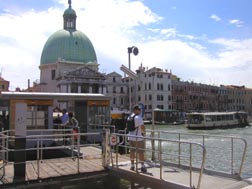
Water taxis from the train station arrive at the Bauer or Palazzo entrances in 15 minutes. The closest vaporetto stop is San Marco Vallaresso, line 1 (45 minutes) or 82. The hotel will pick up luggage there from clients who provide train arrival times.
Getting there: The best way to get to Venice is by train. Note that just past track 1 at the Santa Lucia station is a ramp down which you can wheel out your luggage; there are no signposts to it, and we saw people bumping their bags down the many stairs at the front of the station. When you return to the station, the ramp will be on the right of the building. Vaporettos and water taxis stop just outside the station.
We had Eurail passes from RailEurope, which allowed us to hop on the train from Florence to Venice and then days later to depart Venice easily for our next destination, Bern. Trains between Florence and Venice, both prime tourist destinations, depart frequently, but fill up in season, so get a seat reservation in advance. With RailEurope, you can do that online when you buy your pass or even after you are in Europe from any internet café or hotel connection. That‘s a real timesaver – no extra trips to the station or waiting in lines.
Our Eurail pass allowed 15 days of travel within two months all over Europe. Other passes are available for single or two or three countries. Or get consecutive-day 1st-class travel in Europe for 15 days, 21 days, one month, 2 months or 3 months. Passes are sold only to non-European residents. For information about these and more plans and to purchase passes, contact RailEurope or 888-382-7245.

